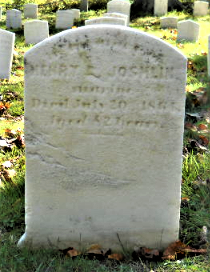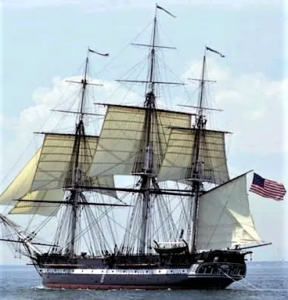Title: Marine Corps Sergeant, War of 1812, POW
Birthdate: 1782
Death Date: July 20, 1864
Plot Location: Naval 2, Row 5, Grave 5 GPS: 39.93648* N, 75.23982* W

Henry is said to have been born in Albany, New York. His name is mentioned in an order book kept by General James Wilkinson, senior officer of the U.S. Army, where he was enlisted June 12, 1805 and assigned to Captain Lockwood’s company. Another source says it was December 17, 1810 as hostilities were brewing between England and the United States. The United Kingdom, as it was known then, supported Native American tribes in the Great Lakes region who opposed U.S. expansion into their territory. It also tried to impose restrictions on American trade with France, so the U.S. declared war on June 18, 1812.
Henry first served in New Orleans in 1811 and 1812. He was a member of the Marine Guard on board the USS Constitution from late 1813 to early 1815. The end of the war came on Christmas Eve, 1814 when the Treaty of Ghent was signed, but it wasn’t ratified for another two months. The Constitution continued to troll the Atlantic near Bermuda, as other frigates were doing, to disrupt British trade by capturing merchant ships and plundering their freight. Navy ships acted like pirates without orders, but that’s what the British ships were doing.
by capturing merchant ships and plundering their freight. Navy ships acted like pirates without orders, but that’s what the British ships were doing.
The Constitution captured a British naval ship, the Levant in March, and Henry was part of the crew that took over the vessel. Unfortunately a British squadron caught up and recaptured the Levant, so Henry became a prisoner of war. Meanwhile, the Constitution escaped, preserving its undefeated record. This took place about a month after the peace treaty was ratified but news didn’t reach many of the ships until late April.
Henry was returned to his homeland by July and spent the rest of 1815 at Charlestown Naval Yard in Boston. That’s where the Constitution, known as “Old Ironsides,” remains to this day, the oldest ship still afloat, and still commissioned by the Navy with a crew of 75.
He remained in Boston after his reenlistment that November. While at the New York Navy Yard he was promoted to corporal, then to sergeant in 1819 at Gosport Shipyard in Portsmouth, Virginia. That site is the Navy’s oldest and largest facility, established in 1767. It was recaptured from the Confederates and given its present name, Norfolk Naval Shipyard, in 1862.
Henry had another tour with the Constitution from 1821-24, but was reduced in rank twice. He returned as a private to New York, then back to Gosport in 1827. The rest of his career record is missing, other than service at Marine Barracks in Washington, D.C. in the years before and after 1840. By 1846 he was at the Marine Barracks at the Philadelphia Navy Yard.
There’s no record to indicate any interruption of his service until February 7, 1862, when he was admitted to the U.S. Naval Hospital in Philadelphia. The comment was simply “old age.” He died there two years later at age 82.

Support the Friends of Mount Moriah
Help us in our mission to restore and maintain the beautiful Mount Moriah Cemetery by donating to our cause or volunteering at one of our clean-up events.

